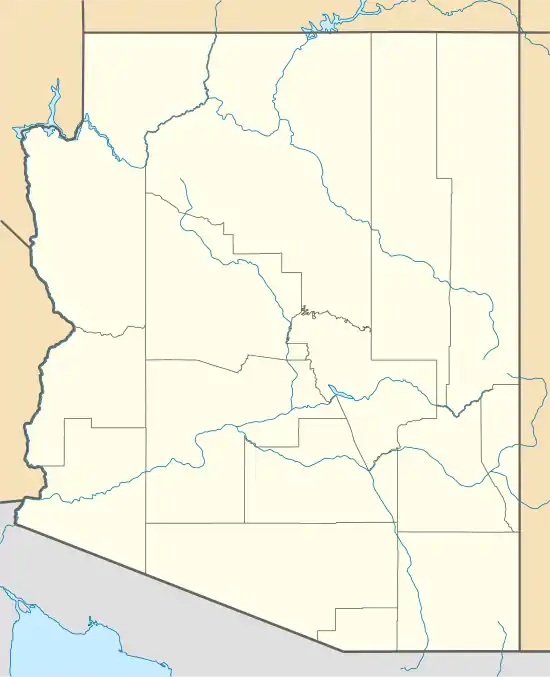
The following is a list of amphibians found in the state of Arizona. The Arizona tree frog is the state amphibian.[1] The state is home to three salamander species.
Arizona is home to a wide variety of biotic systems as it is diverse topographically, geologically, and climatically. The area's sporadic mountains create "sky islands", wherein varying altitudes create drastically different environments inhabited by specific species.[2] For example, the eastern barking frog is only found at altitudes of 1,280–1,890 m on Arizonan mountains. Although the state is mostly arid, river systems such as the Colorado River provide riparian habitats.[3]
List of species
Order Anura
Family Bufonidae
Bufonidae is a family of toads, often called the "true toads". Although a widely varied family, Bufonidae includes the stereotypical toad: dry warty skin and shortened forelimbs and hindlimbs. Bufonids also carry potent skin toxins, sometimes concentrated in the parotoid gland.[4]
| Species | Common name | Distribution | Status[a] | Image |
|---|---|---|---|---|
| Anaxyrus cognatus | Great Plains toad | Found in playa wetlands in Arizona[5] | 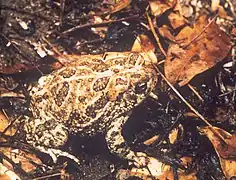 | |
| Anaxyrus debilis | Green toad | Found in southeastern Arizona[7] |  | |
| Anaxyrus microscaphus | Arizona toad | Found in the Virgin River basin of northwestern Arizona[9] | 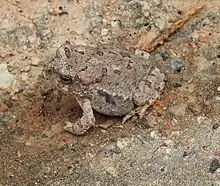 | |
| Anaxyrus punctatus | Red-spotted toad | Abundant in central Arizona[11] |  | |
| Anaxyrus woodhousii | Woodhouse's toad | Found throughout the state[13] | 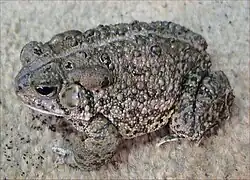 | |
Family Hylidae
Hylidae is a family of frogs which are commonly found in the New World. They may be better known as tree frogs.[15]
| Species | Common name | Distribution | Status | Image |
|---|---|---|---|---|
| Dryophytes arenicolor | Canyon tree frog | Inhaits arid environments and streambanks; often found in pools in canyons[16] | .jpg.webp) | |
| Dryophytes wrightorum | Wright's mountain tree frog | Found in the Petran Montane Conifer Forest Biome along the Mogollon Rim[18] | .jpg.webp) | |
Family Leptodactylidae
| Species | Common name | Distribution | Status | Image |
|---|---|---|---|---|
| Craugastor augusti | Eastern barking frog | Found in the Santa Rita, Pajarito, Huachuca, and Quinlan Mountains in southeast Arizona at elevations of 1,280–1,890 m; report of specimen found in Sierra Ancha mountains of central Arizona[19] |  | |
Family Microhylidae
Microhylidae is a family of frogs. They can often be identified by their tear-dropped shape, hence the common name "narrow-mouthed frogs".[21]
| Species | Common name | Distribution | Status | Image |
|---|---|---|---|---|
| Gastrophryne olivacea | Great Plains narrowmouth frog | Inhabit south-central Arizona[22] |  | |
Family Ranidae
Ranidae, true frogs, are the largest family of frogs. Members of this family, called Ranids, typically have robust hindlimbs, toe webbing, and an aquatic tadpole stage.[24]
| Species | Common name | Distribution | Status | Image |
|---|---|---|---|---|
| Lithobates berlandieri | Rio Grande leopard frog | Inhabit the Gila River drainage and associated croplands from Phoenix to the Colorado River confluence[25] |  | |
| Lithobates blairi | Plains leopard frog | An isolated population cluster in southeastern Arizona[27] | .jpg.webp) | |
| Lithobates catesbeianus | Bullfrog | Common in Arizona[29] | 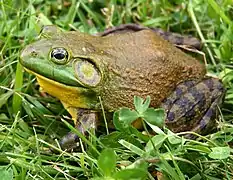 | |
Family Scaphiopodidae
Scaphiopodidae are a family of frogs. Commonly called spadefoot frogs, they are often inconspicuously coloured. Members of this family are predominantly fossorial, living underground until rain arrives. To aid in digging, they have keratinized protrusions on their feet.[31]
| Species | Common name | Distribution | Status | Image |
|---|---|---|---|---|
| Spea bombifrons | Plains spadefoot toad | Found in eastern Arizona[32] |  | |
| Scaphiopus couchii | Couch's spadefoot toad | Central and southeastern portions of the state[34] | 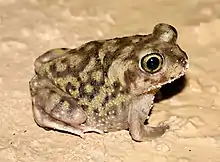 | |
Order Urodela
Family Ambystomatidae
| Species | Common name | Distribution | Status | Image |
|---|---|---|---|---|
| Ambystoma mavortium | Barred tiger salamander | Introduced to southern Arizona[36] |  | |
| Ambystoma rosaceum | Tarahumara salamander | Present in Arizona[38] | 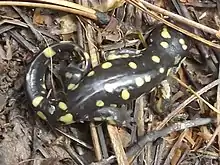 | |
| Ambystoma tigrinum | Eastern tiger salamander | Distinct subspecies Ambystoma tigrinum stebbinsi, known as the Sonora tiger Salamander found on southern border[40] |  | |
Notes and references
Notes
^ a: Conservation status at a world level of the species according to the IUCN Red List: Conservation status - IUCN Red List of Threatened Species:
- EX - Extinct
- EW - Extinct in the wild
- CR - Critically endangered
- EN - Endangered
- VU - Vulnerable
- NT - Near threatened
- LC - Least concern
- DD - Data deficient
- NE - Not evaluated
References
- ↑ "State Amphibian". Arizona State Library. Archived from the original on December 19, 2019. Retrieved December 13, 2020.
- ↑ "The 100-Mile Circle". Tucson Herpetological Society. Retrieved December 13, 2020.
- ↑ R. Roy Johnson. The Lower Colorado River: A Western System (PDF) (Report). US Forest Service. Retrieved December 13, 2020.
- ↑ "Bufonidae". AmphibiaWeb. University of California, Berkeley. Archived from the original on September 24, 2020. Retrieved October 3, 2020.
- ↑ "Anaxyrus cognatus". AmphibiaWeb. University of California, Berkeley. Archived from the original on January 9, 2017. Retrieved December 13, 2020.
- ↑ IUCN SSC Amphibian Specialist Group (2015). "Anaxyrus cognatus". IUCN Red List of Threatened Species. 2015: e.T54612A53949260. doi:10.2305/IUCN.UK.2015-4.RLTS.T54612A53949260.en.
- ↑ "Anaxyrus debilis". AmphibiaWeb. University of California, Berkeley. Archived from the original on October 24, 2020. Retrieved December 12, 2020.
- ↑ Hammerson, G.; Santos-Barrera, G. (2004). "Anaxyrus debilis". IUCN Red List of Threatened Species. 2004: e.T54626A11177308. doi:10.2305/IUCN.UK.2004.RLTS.T54626A11177308.en.
- ↑ "Anaxyrus microscaphus". AmphibiaWeb. University of California, Berkeley. Retrieved December 13, 2020.
- ↑ Hammerson, G.; Schwaner, T. (2004). "Anaxyrus microscaphus". IUCN Red List of Threatened Species. 2004: e.T54709A11189148. doi:10.2305/IUCN.UK.2004.RLTS.T54709A11189148.en.
- ↑ "Anaxyrus punctatus". AmphibiaWeb. University of California, Berkeley. Archived from the original on June 1, 2017. Retrieved December 12, 2020.
- ↑ Hammerson, G.; Santos-Barrera, G. (2010). "Anaxyrus punctatus". IUCN Red List of Threatened Species. 2010: e.T54739A11197415. doi:10.2305/IUCN.UK.2010-2.RLTS.T54739A11197415.en.
- ↑ "Anaxyrus woodhousii". AmphibiaWeb. University of California, Berkeley. Archived from the original on January 26, 2017. Retrieved December 11, 2020.
- ↑ Hammerson, G.; Santos-Barrera, G. (2004). "Anaxyrus woodhousii". IUCN Red List of Threatened Species. 2004: e.T54798A11195037. doi:10.2305/IUCN.UK.2004.RLTS.T54798A11195037.en.
- ↑ "Hylidae". AmphibiaWeb. University of California, Berkeley. Archived from the original on May 3, 2020. Retrieved September 13, 2020.
- ↑ "Hyla arenicolor". AmphibiaWeb. University of California, Berkeley. Archived from the original on October 27, 2020. Retrieved December 11, 2020.
- ↑ Hammerson, G.A.; Santos-Barrera, G. (2017) [2010]. "Dryophytes arenicolor". IUCN Red List of Threatened Species. 2010: e.T55396A112711835. doi:10.2305/IUCN.UK.2017-1.RLTS.T55396A112711835.en.
- ↑ "Dryophytes wrightorum". AmphibiaWeb. University of California, Berkeley. Archived from the original on October 15, 2019. Retrieved December 12, 2020.
- ↑ "Craugastor augusti". AmphibiaWeb. University of California, Berkeley. Archived from the original on April 5, 2016. Retrieved December 12, 2020.
- ↑ Hammerson, G.; Santos-Barrera, G.; Ponce-Campos, P. (2010). "Craugastor augusti". IUCN Red List of Threatened Species. 2010: e.T56438A11478221. doi:10.2305/IUCN.UK.2010-2.RLTS.T56438A11478221.en.
- ↑ "Microhylidae". AmphibiaWeb. University of California, Berkeley. Archived from the original on August 19, 2020. Retrieved October 3, 2020.
- ↑ "Gastrophryne olivacea". AmphibiaWeb. University of California, Berkeley. Archived from the original on September 13, 2020. Retrieved September 13, 2020.
- ↑ Santos-Barrera, G.; Hammerson, G. (2004). "Gastrophryne olivacea". IUCN Red List of Threatened Species. 2004: e.T57815A11687076. doi:10.2305/IUCN.UK.2004.RLTS.T57815A11687076.en.
- ↑ "Ranidae". AmphibiaWeb. University of California, Berkeley. Archived from the original on September 23, 2020. Retrieved October 8, 2020.
- ↑ "Rana berlandieri". AmphibiaWeb. University of California, Berkeley. Archived from the original on June 5, 2020. Retrieved December 13, 2020.
- ↑ Santos-Barrera, Georgina; Hammerson, G.; Köhler, G.; Wilson, L.; Lee, J.; Vázquez, R.C. (2010). "Lithobates berlandieri". IUCN Red List of Threatened Species. 2010: e.T58561A11804296. doi:10.2305/IUCN.UK.2010-2.RLTS.T58561A11804296.en.
- ↑ "Rana blairi". AmphibiaWeb. University of California, Berkeley. Archived from the original on October 16, 2019. Retrieved December 12, 2020.
- ↑ IUCN SSC Amphibian Specialist Group (2014). "Lithobates blairi". IUCN Red List of Threatened Species. 2014: e.T58562A64301057. doi:10.2305/IUCN.UK.2014-3.RLTS.T58562A64301057.en.
- ↑ "Rana catesbeiana". AmphibiaWeb. University of California, Berkeley. Archived from the original on April 5, 2020. Retrieved December 13, 2020.
- ↑ IUCN SSC Amphibian Specialist Group (2015). "Lithobates catesbeianus". IUCN Red List of Threatened Species. 2015: e.T58565A53969770. doi:10.2305/IUCN.UK.2015-4.RLTS.T58565A53969770.en.
- ↑ "Scaphiopodidae". AmphibiaWeb. University of California, Berkeley. Archived from the original on October 30, 2020. Retrieved October 9, 2020.
- ↑ "Spea bombifrons". AmphibiaWeb. University of California, Berkeley. Archived from the original on October 8, 2020. Retrieved December 12, 2020.
- ↑ IUCN SSC Amphibian Specialist Group (2015). "Spea bombifrons". IUCN Red List of Threatened Species. 2015: e.T59044A53972679. doi:10.2305/IUCN.UK.2015-4.RLTS.T59044A53972679.en.
- ↑ "Scaphiopus couchii". AmphibiaWeb. University of California, Berkeley. Archived from the original on November 2, 2020. Retrieved December 13, 2020.
- ↑ Santos-Barrera, G.; Hammerson, G. (2004). "Scaphiopus couchii". IUCN Red List of Threatened Species. 2004: e.T59041A11874119. doi:10.2305/IUCN.UK.2004.RLTS.T59041A11874119.en.
- ↑ "Ambystoma mavortium ". AmphibiaWeb. University of California, Berkeley. Archived from the original on August 22, 2019. Retrieved December 12, 2020.
- ↑ IUCN SSC Amphibian Specialist Group. (2015). "Ambystoma mavortium". IUCN Red List of Threatened Species. 2015: e.T199970A2623523. doi:10.2305/IUCN.UK.2015-4.RLTS.T199970A2623523.en.
- ↑ "Ambystoma rosaceum". AmphibiaWeb. University of California, Berkeley. Archived from the original on October 23, 2020. Retrieved December 12, 2020.
- ↑ IUCN SSC Amphibian Specialist Group (2015). "Ambystoma rosaceum". IUCN Red List of Threatened Species. 2015: e.T59068A53974550. doi:10.2305/IUCN.UK.2015-4.RLTS.T59068A53974550.en.
- ↑ "Sonora tiger Salamander (Ambystoma tigrinum stebbinsi)". ECOS Environmental Conservation Online System. U.S. Fish and Wildlife Service. Archived from the original on October 16, 2020. Retrieved December 12, 2020.
- ↑ IUCN SSC Amphibian Specialist Group (2015). "Ambystoma tigrinum". IUCN Red List of Threatened Species. 2015: e.T83293207A3076038. doi:10.2305/IUCN.UK.2015-4.RLTS.T83293207A3076038.en.